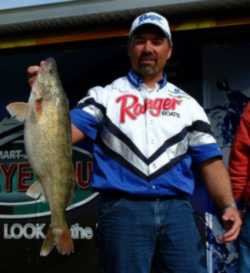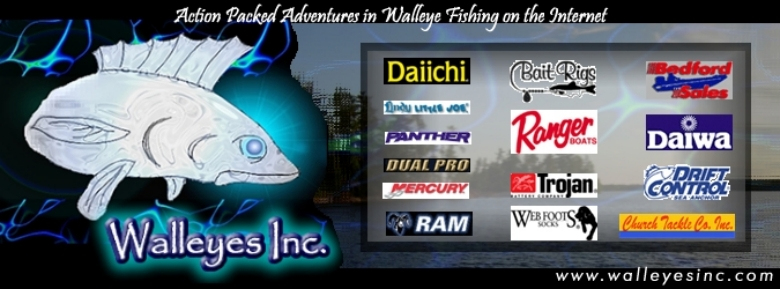| Plastics have really made an impact on river
walleye fishing. Plastics allow anglers to change shapes, colors
and size with an ease that cannot be accomplished with the traditional
minnow or shiner. Jigs tipped with a plastic body often shine
in river fishing conditions for a variety of reasons. First
off, the current present in rivers sweeps the jig by fish and
fish have to decide quickly if they are going to eat. Often,
the fish don’t get a chance to scrutinize the bait or
lure.
Gulp! Alive tastes good enough and smells good enough, long
enough to work well on every river we have fished on the FLW
Walleye Tour. The other factor that makes plastics so effective
is that we can use bright or fluorescent colors in turbid
or muddy conditions for better visibility. We can also experiment
with shapes to manipulate the visibility, vibration, size
and action. Now for the best part, plastic stays on the jig
better than live bait. Cast after cast, plastics stay on the
hook. Miss a fish, no problem as the worst thing that usually
happens is the fish bites off the tail. In contrast, with
traditional live bait, we are in the water a higher percentage
of the time fishing unproductively without bait, naked because
the bait tore off the hook.
 |
Now the point of this article isn’t
to convince you that plastics are better than traditional
fatheads, shiners or a half crawler for tipping jigs as
there is a time and place for live bait but on many river
situations, we are often leaving the live bait in the
cooler or bait well. Plastics work that good. Pitching
up onto shoreline eddies and wing dams is a very productive
spring presentation on rivers across the region. Casting
jigs tipped with plastic tails either cross current or
casting them downstream and slowly dragging them back
is a very effective way to work plastics so that they
catch fish. Dragging the jig upstream gives the body a
lot of action as the plastic gets pulled against the current.
Cross current approaches generally gives the jig a natural
downstream sweep that fish have to snap at out of reaction
as the window of opportunity is short, thus a perfect
scenario for plastics. |
A mistake we see many anglers make when using plastics on
rivers is going to light with the jig. The plastic body will
cause some lift on the jig. When learning how to read water
and fish plastics, err on the side of heavier so that you
know the jig is in the zone it needs to be when fishing current
and that zone is right close to the bottom. There is a constant
debate amongst anglers who fish a lot of jigs about using
no stretch lines like Fire Line and traditional monofilament
that does have some stretch. For many vertical presentations
and some dragging, I love the Fire Line Crystal. But for casting
or pitching, I do prefer mono because the action on the jig
seems more natural and fluid. My favorite line for this is
high visibility Berkley Sensation. Most anglers stress the
importance of a highly sensitive graphite spinning rod in
either six or seven feet with a medium action, fast tip. One
rod in particular that I really like for many different jigging
applications is the Jason Mitchell Elite Series JMS66MF that
has really exploded onto the rod scene in the past few years.
Plastics are not an end all and will never completely replace
live bait but there are situations where I used to really
rely on live bait but could just as well leave the bait at
home. River walleye fishing opportunities are one such situation
where I have a lot of confidence with plastics.
Editors Note: The author, Troy Morris is one of the top rated
walleye anglers on the FLW Walleye Tour and sales rep for
Ranger Boats, www.rangerboats.com. Troy lives in Bismarck
North Dakota and is on the National Pro Team for Ranger Boats,
Evinrude, Lowrance and Minnkota.
|

